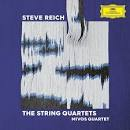The music, the performances and the meaningful musical synergy present on this revelatory recording of Steve Reich's The String Quartets (DGG Deutsche Grammophon 5385) by the Mivos Quartet helps us experience in good order some of the masterpieces that confirm why Steve Reich is no doubt among the very most important of Minimalist Composers but also aside from style a towering musical figure of our era.
Modern classical and avant garde concert music of the 20th and 21st centuries forms the primary focus of this blog. It is hoped that through the discussions a picture will emerge of modern music, its heritage, and what it means for us.
Search This Blog
Monday, August 28, 2023
Steve Reich, The String Quartets, Mivos Quartet
Wednesday, August 16, 2023
Georgina Isabel Rossi and Silvie Cheng, Chorinho for Viola and Piano
Monday, August 14, 2023
Amaro Dubois, TingTing Yao, Luz for Viola and Piano
Viola tonemaster Amaro Dubois teams with ultra-sensitive accompanist-pianist TingTing Yao for a intoxicating mélange of heady but balanced lyricism and folk-infused earthiness on the well paced and nuanced album Luz (Navona NV6491). The entire program revolves around a most dedicated kind of impassioned presence bristling with New World fountainheads of melodic brilliance.
We start in the mold with composer Edmundo Villani Cortes and the title piece "Luz" and move through a consistently invigorating cache of memorable presence and a totally refreshed familiarity as in the folk and spiritual heritage of the North American African diaspora with spiritual and folk vibrant mini-gems from Florent Price, William Grant Still, Michael Tippet and then too South American rejuvenations of the roots of an exuberant effusiveness via Dimitri Cervo, Heitor Villa-Lobos, Edmundo Villani-Cortes, Jose Elizondo, and Zequinha de Abreu.
As you listen to Luz ideally and gradually you enter into the musical representation and feeling of light coupled with a threesome presence of passion, love and peace--and in the process ideally feel a consistently ravishing burnishment of the rich viola tone in conjunction its counterpart in the steady, folk- driven energy and vivacity of TingTing Yao's supercharged accompaniment.
It is just enough folkishly over the top at times that it jumps out without pretense and always with an unabashedly human quality. It all lets in a nice helping of sunshine at a time when we all no doubt would like to respond and recharge through a healing experience, with a good deal of musical hope and reassured resolve that nowadays would be most welcome to many. Hear it by all means. Listen to the whole album on YouTube: https://www.navonarecords.com/catalog/nv6491/
Thursday, August 3, 2023
Taylor Joshua Rankin, Sun, Will Grow, New Music of an Unexpected Sort
So this is some music of the moment and perhaps of our musical future, too. A big bravo and kudos on this one from concept to execution. I most definitely want you to hear this one if you can; head on over to Bandcamp for a run through of it all for free, then order it there if you like: https://taylorjoshuarankin.bandcamp.com/album/sun-will-grow Or if you are pressed for time. take a listen to a 2,5 minute series of excerpts on YouTube https://www.youtube.com/watch?v=4cWrBWdmTfI
Tuesday, August 1, 2023
Jenny Beck, Up to the Surface, New and Very Personal Electronic Music
In an era that culminated perhaps in the interjection of electronics into every avenue of Pop music, we see a continued, healthful response from the New Music worlds, not the least which is the Electronic, New Music work out soon as an EP, Up to the Surface (New Focus Recordings Digital Release) by composer/sound artist Jenny Beck. This is an integrated four movement work that achieves a true individuation as a soundscape, a continuous coloration envelope of distinction. It does not seek to beguile the senses with repetitive sonic mantras so much as to prevail with continuous walls of presence, a flight into the realm of pure musical re-imagination perhaps, and the mellifluous ability to create a shifting ground of sound spatial animation, wellsprings of aesthetically pleasing continuance.
A thorough grounding I think constantly in this work is the idea that repeated listens are critical to grasp intuitively the structure of the music as a whole. Accordingly I have listened many times before reviewing.
The title of each movement, not surprisingly gives as good idea as anything as to the contentful motion of the work and its unfolding meaning. So starting with the first movement we encounter "Some Place Sacred and Submerged," then on to 2: "Radiant Currents," then "In the Ether" and on to the final "Wake." Combine all that with the overall title Up to the Surface and so perhaps we get a kind of allegorical trip through to a kind of enlightenment, a special knowledge imparted via sound. It is suspension in ordinary spacetime and perhaps the sort of sounds denoting traveling through liquid, or even becoming a sounding liquid itself? You listen for yourself and decide.
And so it is a sonic journey and in the end did we get to where we wanted to go? Probably so the less we let the hereafter words pin us as to a literal meaning. The Bandcamp notes give us a little from their end, that is, that they go on to tell us that such timbral ambience is not run-of-the-mill thing (it isn't) and that we should listen as the dynamic soundscape evolves and changes them to so many "teenage electro-werewolves," to a unique and potentially newly paradigmatic musical soundscape.
The music is somewhat modest, unassuming, subtle. It does not speak in a loud manner or with a hint of anger or arrogance. It exerts, perhaps, the composer's personality, whimsical yet cosmic. I keep listening and it feels increasingly unique, timbrally distinct and personal. Bravo. The totalized world is electronic and a combo of relatively clean tones without being pure sine waves but also colored in ways that add a bit of pleasing granular texture if you will.
Stream the first movement or total album once released: https://newfocusrecordings.bandcamp.com/album/up-to-the-surface




